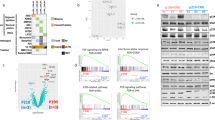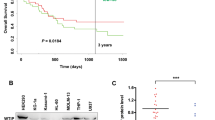Abstract
The regulation of protein kinase B (AKT) is a dynamic process that depends on the balance between phosphorylation by upstream kinases for activation and inactivation by dephosphorylation by protein phosphatases. Phosphorylated AKT is commonly found in acute myeloid leukemia (AML) and confers an unfavorable prognosis. Understanding the relative importance of upstream kinases and AKT phosphatase in the activation of AKT is relevant for the therapeutic targeting of this signaling axis in AML. The B55α subunit of protein phosphatase 2A (PP2A) has been implicated in AKT dephosphorylation, but its role in regulating AKT in AML is unknown. We examined B55α protein expression in blast cells derived from 511 AML patients using reverse phase protein analysis. B55α protein expression was lower in AML cells compared with normal CD34+ cells. B55α protein levels negatively correlated with threonine 308 phosphorylation levels. Low levels of B55α were associated with shorter complete remission duration, demonstrating that decreased expression is an adverse prognostic factor in AML. These findings suggest that decreased B55α expression in AML is at least partially responsible for increased AKT signaling in AML and suggests that therapeutic targeting of PP2A could counteract this.
This is a preview of subscription content, access via your institution
Access options
Subscribe to this journal
Receive 12 print issues and online access
$259.00 per year
only $21.58 per issue
Buy this article
- Purchase on Springer Link
- Instant access to full article PDF
Prices may be subject to local taxes which are calculated during checkout







Similar content being viewed by others
References
Martelli AM, Evangelisti C, Chiarini F, McCubrey JA . The phosphatidylinositol 3-kinase/Akt/mTOR signaling network as a therapeutic target in acute myelogenous leukemia patients. Oncotarget 2010; 1: 89–103.
Fathi AT, Grant S, Karp JE . Exploiting cellular pathways to develop new treatment strategies for AML. Cancer Treat Rev 2010; 36: 142–150.
Samudio I, Konopleva M, Carter B, Andreeff M . Apoptosis in leukemias: regulation and therapeutic targeting. Cancer Treat Res 2010; 145: 197–217.
Martelli AM, Evangelisti C, Chiarini F, Grimaldi C, Manzoli L, McCubrey JA . Targeting the PI3K/AKT/mTOR signaling network in acute myelogenous leukemia. Expert Opin Investig Drugs 2009; 18: 1333–1349.
Martelli AM, Nyåkern M, Tabellini G, Bortul R, Tazzari PL, Evangelisti C et al. Phosphoinositide 3-kinase/Akt signaling pathway and its therapeutical implications for human acute myeloid leukemia. Leukemia 2006; 20: 911–928.
Scholl C, Gilliland DG, Fröhling S . Deregulation of signaling pathways in acute myeloid leukemia. Semin Oncol 2008; 35: 336–345.
Kornblau SM, Tibes R, Qiu YH, Chen W, Kantarjian HM, Andreeff M et al. Functional proteomic profiling of AML predicts response and survival. Blood 2009; 113: 154–164.
Kornblau SM, Womble M, Qiu YH, Jackson CE, Chen W, Konopleva M et al. Simultaneous activation of multiple signal transduction pathways confers poor prognosis in acute myelogenous leukemia. Blood 2006; 108: 2358–2365.
Gallay N, Dos Santos C, Cuzin L, Bousquet M, Simmonet Gouy V, Chaussade C et al. The level of AKT phosphorylation on threonine 308 but not on serine 473 is associated with high-risk cytogenetics and predicts poor overall survival in acute myeloid leukaemia. Leukemia 2009; 23: 1029–1038.
Hunter T . Protein kinases and phosphatases: the yin and yang of protein phosphorylation and signaling. Cell 1995; 80: 225–236.
Millward TA, Zolnierowicz S, Hemmings BA . Regulation of protein kinase cascades by protein phosphatase 2A. Trends Biochem Sci 1999; 24: 186–191.
Liao Y, Hung MC . Physiological regulation of Akt activity and stability. Am J Transl Res 2010; 2: 19–42.
Kuo YC, Huang KY, Yang CH, Yang YS, Lee WY, Chiang CW . Regulation of phosphorylation of Thr-308 of Akt, cell proliferation, and survival by the B55alpha regulatory subunit targeting of the protein phosphatase 2A holoenzyme to Akt. J Biol Chem 2008; 283: 1882–1892.
Chen W, Possemato R, Campbell KT, Plattner CA, Pallas DC, Hahn WC . Identification of specific PP2A complexes involved in human cell transformation. Cancer Cell 2004; 5: 127–136.
Chen W, Arroyo JD, Timmons JC, Possemato R, Hahn WC . Cancer-associated PP2A Aalpha subunits induce functional haploinsufficiency and tumorigenicity. Cancer Res 2005; 65: 8183–8192.
McCright B, Virshup DM . Identification of a new family of protein phosphatase 2A regulatory subunits. J Biol Chem 1995; 270: 26123–26128.
Janssens V, Longin S, Goris J . PP2A holoenzyme assembly: in cauda venenum (the sting is in the tail). Trends Biochem Sci 2008; 33: 113–121.
Strack S, Cribbs JT, Gomez L . Critical role for protein phosphatase 2A heterotrimers in mammalian cell survival. J Biol Chem 2004; 279: 47732–47739.
Eichhorn PJ, Creyghton MP, Bernards R . Protein phosphatase 2A regulatory subunits and cancer. Biochim Biophys Acta 2009; 1795: 1–15.
Sontag E, Nunbhakdi-Craig V, Bloom GS, Mumby MC . A novel pool of protein phosphatase 2A is associated with microtubules and is regulated during the cell cycle. J Cell Biol 1995; 128: 1131–1144.
McCright B, Rivers AM, Audlin S, Virshup DM . The B56 family of protein phosphatase 2A (PP2A) regulatory subunits encodes differentiation-induced phosphoproteins that target PP2A to both nucleus and cytoplasm. J Biol Chem 1996; 271: 22081–22089.
Ruvolo PP, Clark W, Mumby M, Gao F, May WS . A functional role for the B56 alpha subunit of protein phosphatase 2A in ceramide-mediated regulation of Bcl2 phosphorylation status and function. J Biol Chem 2002; 277: 22847–22852.
Kornblau SM, Singh N, Qiu Y, Chen W, Zhang N, Coombes KR . Highly phosphorylated FOXO3A is an adverse prognostic factor in acute myeloid leukemia. Clin Cancer Res 2010; 16: 1865–1874.
Hu J, He X, Baggerly KA, Coombes KR, Hennessy BT, Mills GB . Non-parametric quantification of protein lysate arrays. Bioinformatics 2007; 23: 1986–1994.
Neeley ES, Kornblau SM, Coombes KR, Baggerly KA . Variable slope normalization of reverse phase protein arrays. Bioinformatics 2009; 25: 1384–1389.
Li X, Scuderi A, Letsou A, Virshup DM . B56-associated protein phosphatase 2A is required for survival and protects from apoptosis in Drosophila melanogaster. Mol Cell Biol 2002; 22: 3674–3684.
Perrotti D, Neviani P . Protein phosphatase 2A (PP2A), a drugable tumor suppressor in Ph1(+) leukemias. Cancer Metastasis Rev 2008; 27: 159–168.
Neviani P, Santhanam R, Trotta R, Notari M, Blaser BW, Liu S et al. The tumor suppressor PP2A is functionally inactivated in blast crisis CML through the inhibitory activity of the BCR/ABL-regulated SET protein. Cancer Cell 2005; 8: 355–368.
Cristóbal I, Blanco FJ, Garcia-Orti L, Marcotegui N, Vicente C, Rifon J et al. SETBP1 overexpression is a novel leukemogenic mechanism that predicts adverse outcome in elderly patients with acute myeloid leukemia. Blood 2010; 115: 615–625.
Thimmaiah KN, Easton JB, Houghton PJ . Protection from rapamycin-induced apoptosis by insulin-like growth factor-I is partially dependent on protein kinase C signaling. Cancer Res 2010; 70: 2000–2009.
Basu S, Ray NT, Atkinson SJ, Broxmeyer HE . Protein phosphatase 2A plays an important role in stromal cell-derived factor-1/CXC chemokine ligand 12-mediated migration and adhesion of CD34+ cells. J Immunol 2007; 179: 3075–3085.
Acknowledgements
We thank Pankil Shah for work on statistical analysis. This work was supported by the Leukemia and Lymphoma Society (Grant 6089) and the National Institutes of Health (PO1 Grant CA-55164).
Author information
Authors and Affiliations
Corresponding authors
Ethics declarations
Competing interests
The authors declare no conflict of interest.
Rights and permissions
About this article
Cite this article
Ruvolo, P., Qui, Y., Coombes, K. et al. Low expression of PP2A regulatory subunit B55α is associated with T308 phosphorylation of AKT and shorter complete remission duration in acute myeloid leukemia patients. Leukemia 25, 1711–1717 (2011). https://doi.org/10.1038/leu.2011.146
Received:
Revised:
Accepted:
Published:
Issue Date:
DOI: https://doi.org/10.1038/leu.2011.146
Keywords
This article is cited by
-
GqPCR-stimulated dephosphorylation of AKT is induced by an IGBP1-mediated PP2A switch
Cell Communication and Signaling (2022)
-
PP2A-B55: substrates and regulators in the control of cellular functions
Oncogene (2022)
-
RhoB loss induces Rac1-dependent mesenchymal cell invasion in lung cells through PP2A inhibition
Oncogene (2016)
-
Altered PPP2R2A and Cyclin D1 expression defines a subgroup of aggressive luminal-like breast cancer
BMC Cancer (2015)



